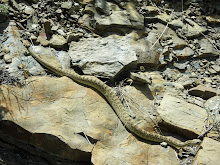
This section has been interpreted as a large carbonate ramp, and is chock full of stromatoporoid sponge mounds (such as in the picture below). These sponges were the dominant reef-building critters in the Devonian.

There were also some sections dominated by fragments of a wispy, thin-walled Amphipora, which is also a stromatoporoid (thanks Shanan!) that must have been getting beat-up and sloshed around before its final deposition (below):

Thankfully, there were SOME bedforms to be seen in amongst the carbonates; the picture below shows some calciclactic (ooidal) HCS and SCS; this high energy lithofacies always capped off the shallowing-upward cycles (parasequences) preserved in this overall shallowing upward succession.

Further up the canyon, we were able to follow these carbonates all the way up to a pretty slick surface. The picture below shows a fairly important transition in the geological history of the world; the tan-orange stuff to the right in all shore-face sands (trough and planar x-beds, HCS and SCS, ripples, and shelly detritus), whereas the darker stuff to the left is all siliciclastic mud interbedded with thin carbonates.

It is pretty clearly a flooding surface, putting deeper-water units overtop of shallower, coarser units. But what is really nifty is the paleo story preserved here. Below that contact, there were stromatoporoid reefs; above that contact, there are only crinoids. Turns out, this is the Frasnian-Fammenian boundary, the smallest of the “big-5” extinction events. The stromatoporoids (and trilobites) got whacked pretty hard during this "event", and were replaced by the more familiar post-Devonian faunas and reefs (such as crinoid-reefs).




4 comments:
I like the way you are posting about your D.V. field trip - a post for each day. I might try that with one of my recent trips. I thought of inserting them into the blog on the day they happened (by using previous dates, the dates of each field trip day), but I like the way yours are coming out.
Oh, you used that recently "debated" word - miogeocline!
As you well know, the geology out there in Death Valley is just too great; I ended up with so many pictures, that I felt that I had to split em up.
And I shall name first born "Miogeocline".
The "spaghetti rock" with the wispy fossil fragments is made up of Amphipora, which is also a stromatoporoid.
Thanks for the correction, Shanan!
Post a Comment